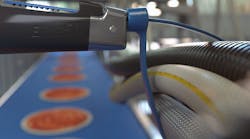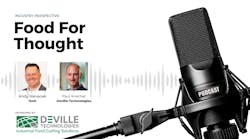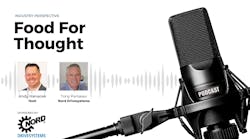Do you know the average cost of contamination at a food and beverage plant? If you guessed between $10-30 million in direct costs, you’d be right. If you’re at a plant where bacteria reduction and detectability are crucial, everything that comes into contact with your products must be safe. Whether it’s a gearbox, a motor, a conveyor, or even a cable tie, you want safe, and you want microorganism-free.
With us on the podcast today are Brian Barr and John Archer, both of ABB. In this episode, we’re talking about the options food and beverage processors have when it comes antimicrobial cable ties. ABB recently expanded its line of Ty-Rap® cable ties with Ty-Rap® TyGenic™ cable ties, the industry’s first two-piece antimicrobial* and detectable cable tie. We talk about those ties on the episode, along with what products ABB is bringing to the table to help food and beverage processors.
Transcript
Food Processing: Can you talk to us about some of the big issues food and beverage companies are concerned about right now?
ABB is a leading global technology company that energizes the transformation of society and industry to achieve a more productive, sustainable future. By connecting software to its electrification, robotics, automation and motion portfolio, ABB pushes the boundaries of technology to drive performance to new levels. Learn More at www.abb.com
Brian Barr: You have liquid ingress, condensation, corrosion, electrical components and equipment not holding up to the process, wash down, or the people in the plant. You also have products being used that are not properly rated for environment where they are being installed. One thing that is more of a priority than an issue is safety, whether that’s employee safety or food safety.
There are many things that go into making a facility safe; one is using the correct products. No one wants to experience a food safety recall. One food safety recall is going to add significantly to cost. On average, the cost of a food safety recall is going to be anywhere from $10-$30 million. In my career I've seen that cost exceed hundreds of millions of dollars. There is also the potential harm to the consumer in the form of illness or possibly even death. In today’s food and beverage processing environment we're also seeing individuals being held criminally liable for food safety recalls.
FP: What kind of technology should food processors be considering to help address these concerns?
BB: Material selection is very important as is making sure products are properly rated for the environment that they're going to be installed. Processors should consider design features that are going to increase food safety. These are things like rounding and sloping, avoiding dead spaces, and providing enough space or offset so you can properly clean everything 360 degrees.
Antimicrobial technology has been around for over a century, but it is relatively new to our industry for cable protection and wire management solutions. If someone is installing any products into the food zone or the splash zone, then they would want to use something like antimicrobial to add that higher degree of food safety.
A common misunderstanding of antimicrobial technology is that the product loses effectiveness over time. That’s not true. In reality, the antimicrobial technology kills the cells of harmful microbials. Over time, the dead cells form a membrane around the product allowing new harmful microbials to grow on top of it, thereby eliminating the antimicrobial effectiveness. That only happens if a facility doesn't wash down. One wash down knocks those dead cells off and keeps the antimicrobial properties at 100%. The antimicrobial technology isn’t going to lose effectiveness over time. We anticipate the demand for these types of products to continue to grow.
FP: Can you tell me more about what ABB is bringing to the table from an innovation and product perspective?
John Archer: Absolutely. ABB’s product portfolio is almost second to no one. When you think about what we offer from an electrification standpoint, process automation, robotics, and discrete automation, we're very close to being a one-stop-shop from source to socket.
Concerning innovation, we have seven R&D centers around the world where we spend millions of dollars innovating for food and beverage processors. For example, we opened a food and beverage washdown lab several years ago because we wanted to see how our products held up in a food and beverage environment over several years. Everything looks nice when it's first installed, but how does it hold up five years down the road? That's what one of these R&D centers is working on. We've spent billions on company acquisitions, such as Thomas and Betts, who's been an industry leader with wire management, cable protection, and termination product lines for years. When you think of an electrical system in a food and beverage facility, we touch a large portion of that entire system that is protecting and terminating electrical wires throughout.
FP: Can you explain how ABB decides what products to bring to market
JA: New product ideas come from both inside and outside ABB. Ultimately, it's the voice of the customer; finding out what they need. We do deep dives into understanding our end-customers, both product management and engineering teams. We typically go into these facilities to assess the environment and find solutions to their issues. We take what we see and create products that are more sustainable for our customers. When we do our job site visits, sometimes it's as simple as just asking if there are there any products that don't exist today that they’d like us to make for them. It's all about finding solutions and having the value proposition that makes their life easier, safer, and even more possible on their end as well.
FP: Is there anything new in your product arsenal for food and beverage manufacturers?
JA: Years ago we created a detectable cable tie specifically for the food and beverage market. This is important because if think about a cable tie, you're bundling a set of wires and conduit and conductors, and it may be hanging on the side of a machine, conveyor belt, or electrical system that drives motors. Cable ties are all over these facilities. What happens when you use a cable tie; you trim off the end of it. It's a wasted piece and sometimes those pieces fall on the ground. Sometimes those ends can fall on the conveyor belt and get mixed up in the food. We created a detectable cable tie that was made for metal detection and x-ray equipment, as well as visual inspection. It was molded in a special blue color. We chose our blue because it wasn’t a naturally occurring color the food and beverage chain.
We've been very successful with that product over the years and now we've added a couple of features to it. We’re now launching our Tygenic-brand cable ties. These take our detectable cable tie and add an antimicrobial feature. We’ve also made it stronger.
Our ties are not only detected by vision systems, x-ray equipment, metal detectors, but also 99% effective at preventing the growth of any harmful bacteria on that product. We think this is where the innovation is, in making a specific product with a very good value proposition to a market segment that is very critical to people, to safety, to end users, and our customers. It also gives processors the ability to standardize on just one cable tie as opposed to multiple cable ties.
FP: What led you to develop this product?
JA: It was ultimately the voice of the customer. The detectable Ty-Rap was very successful and our customers—when we went back to the facilities—would ask “what’s next?” Customers told us a big issue they had was with bacterial growth. We had a choice. We could make a separate product and do it that way, or we could combine features and make one product that does both.
It's important for us to build relationships with our customers, to listen to them, and to stay on top of their market. It’s knowing what the problems they’re facing in that market. We have industry experts, product experts, and market experts whose sole job is focused on food and beverage. Then they will bring back that feedback to the product team who are the product experts with their engineers and to solve the problem that was uncovered on site.
FP: Why did you focus on the antimicrobial aspect, particularly getting to a target of 99% antimicrobial?
JA: We wanted to give our food and beverage processors and contractors the product they were looking for, that they were asking for. We want to remain that one stop solution for them. And antimicrobial is just another step down the road. Food and beverage is an extremely busy environment. We want to give them a sustainable product that can be installed and it'll exist for years. It's strong enough to last for years and they can install it, not worry about it, forget about it, move on. And it's just that the peace of mind comes into play too. They know in that facility, that product is not going to cause them a headache down the road.



